Electric bikes have a very bright future in Portland. There are many reasons why: Many Portlanders love cycling and our city encourages it, we have hills and steep bridges to pedal up, our expensive housing is forcing longer bike commutes, and e-bike technology — as technology tends to do — is always getting better/lighter/cheaper.
On that note, I had the opportunity to test ride the Bosch eBike System last week. From what I’ve heard around the industry, their new mid-drive system is the best on the market. As the largest automotive parts supplier in the world and with over a century of experience, it’s not hard to fathom that Bosch could jump into this market and deliver a solid product.
I also noticed that Xtracycle decided to spec the Bosch system on their Edgerunner cargo bike. That alone is a good sign that the Bosch system is worth paying attention to.
Last week Bosch sales and marketing manager Jonathan Weinert showed up outside my office with an Edgerunner for me to ride. On the rear rack he had strapped a suitcase that added about 25-30 pounds to the load. We pedaled over to the Waterfront and did a short loop around the Willamette River.

Morrison Bridge on a loaded cargo bike without
even pedaling hard at all. (That’s Jonathan in front of me.)
The first thing I noticed about the Bosch system was how good it looks on the bike. I’m a stickler for aesthetics when it comes to bikes, and I believe e-bikes will never reach their potential in the U.S. market unless they look cool. The Bosch system is very well-designed and all you see on the bike is the drive unit wrapped around the bottom-bracket area and the battery which is about the size of a square two-liter drink bottle that fits on the downtube.
Advertisement
Bosch’s system also has an intuitive user interface. It only took a few seconds before I understood all the modes and how to cycle through them. There are four riding modes (five if you count “off”): Eco, Tour, Sport and Turbo. Eco gives you the least amount of boost (50% of what you put in) and Turbo gives you the most — a whopping 275% of your own power input. Put into wattage numbers, if you put 100 watts of power into the cranks in Eco mode you’ll get 50 watts of assist from the motor. That same power applied in Turbo mode will give you 375 watts from the motor.
And of course your range (how far you can ride before the battery dies) goes down as the power-assist goes up.
In Eco mode, you get a range of about 75 miles on a full charge in “ideal conditions” and 45 miles in “difficult conditions.” Those numbers go down to 30 and 15 in Turbo mode. If you mix between all four modes you’ll have a range of about 50 miles in good conditions.
The riding experience was really nothing much of an experience at all. And that’s the point. The bike I was on felt like just a regular bike — except of course that it had a boost of power whenever I pedaled. The feel of the e-assist’s power was amazingly smooth to the point of being non-existent, which is a huge credit to he quality of the Bosch system.
The ride was so effortless that – even on this heavy cargo bike — I found myself maxing out the speed at 19-20 mph with very little effort. (As per current laws, the motor stops working at 20 mph.)
This test ride also confirmed for me once and for all that e-bike systems that use a throttle are inferior to gear-driven ones. Having the assist react automatically to my input (instead of me having to twist or push a button for power), means I just pedal like normal, without even thinking about the motor.
Weinert pointed out that the Bosch drive unit has a microprocessor inside it that monitors your wheel’s speed, cadence, and torque whiling making measurements 1000 times per second. Those measurements are then fed into the motor to “give you just the right amount of power to make it imperceptible.”
And lest you think Weinert is just an industry flack paid to sell a product (he is actually, but hear me out), he’s also a former academic from UC Davis. Before his job at Bosch he was in China researching e-bikes’ impacts on health, transportation, and urban planning.
If you’re the market for an e-bike, definitely test ride a bike with the Bosch system installed. The one consideration is that it’s more expensive than other systems. As a comparison, the Bosch-equipped Edgerunner I rode retails for $5,750 and the Yuba Spicy Curry I rode back in May which also has a mid-drive system, retails for $4,500.
In addition to Xtracycle, you can find Bosch on several other brands including Felt, EMotion, Haibike, Lapierre and Cube. In Portland, there are four shops that have Bosch-equipped bikes in stock: Clever Cycles, Cynergy E-Bikes, Splendid Cycles, and The eBike Store.


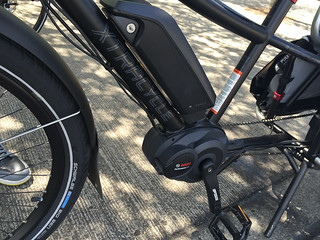
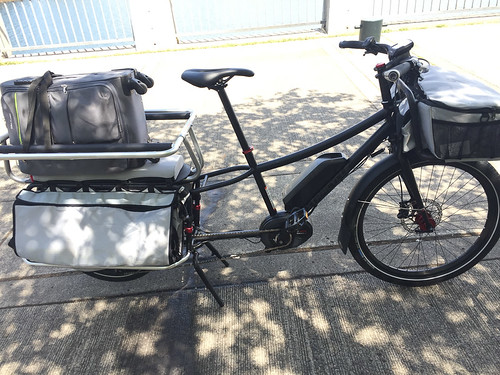
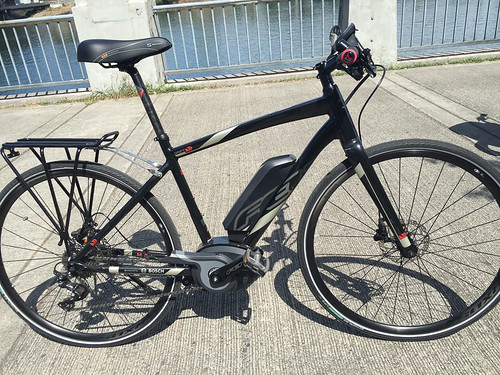
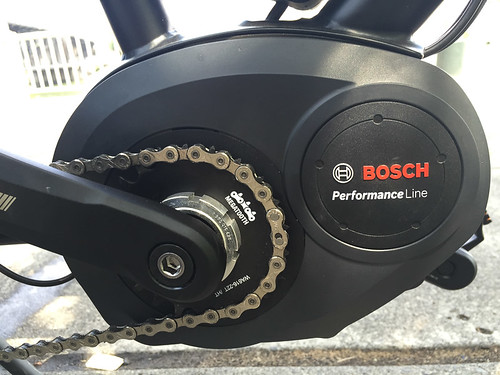
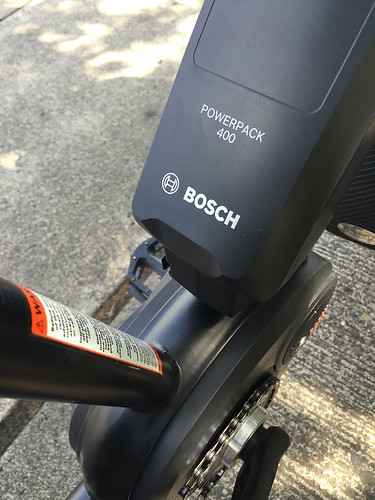

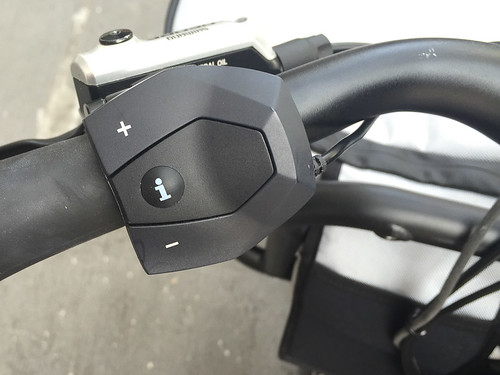
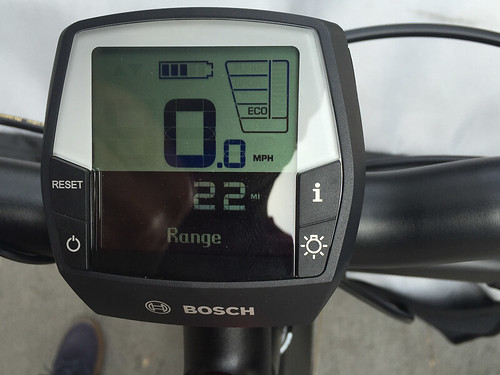



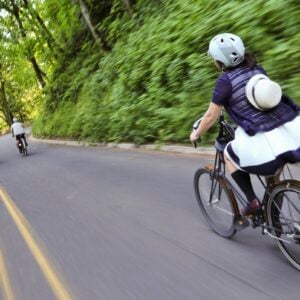
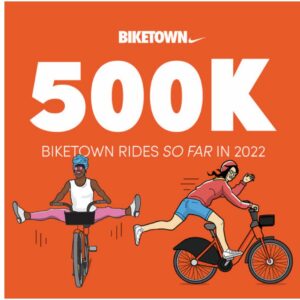
Thanks for reading.
BikePortland has served this community with independent community journalism since 2005. We rely on subscriptions from readers like you to survive. Your financial support is vital in keeping this valuable resource alive and well.
Please subscribe today to strengthen and expand our work.
Thanks for this review! Does the bike have a dynamo to recharge the battery while you ride downhill? What about lights? Are they powered by the battery as well?
Move the freewheel to the electric motor side. Chain would move while you coast, but that could charge the battery.
Real light integration would be a major selling point too. This looks like a cargo bike without lights? (granted, this is Portland in the summer).
My Bionx e-assist Big Dummy (built by Splendid Cycles) has regenerative braking and integrated lights. The regen braking is really handy on long downhills, but I can’t really estimate how much it improves the range. I’m curious to try a mid-drive system like Bosch to compare the feel.
Lights? How about brake lights and turn signals?
That’s called a motorcycle…
No, that weighs at least another 100lb and goes at least another 30mph. Granted, motorcycle LED turn signals and controls are probably what we’ll use.
It’s most likely a DC motor, and you need an AC system to do charging/regen braking. Which would add cost & weight for a pretty small benefit. Obviously some manufacturers have decided it’s worth it, but it’s not as simple as just moving a freewheel. And I’m a big fan of simple.
It’s my understanding that AC is not required for regenerative braking. But you do need a direct drive motor – no freewheeling* – to throw electrons back through the system as you engage regen. Typically done by having an electric switch in a brake lever, so that the initial pull can be electrically detected and engage regen [all electronically via the controller, no mechanical clutches, etc].
Thus, when you coast downhill you can choose to recapture some of that energy by lightly engaging the brake lever without engaging the actual squeeze of your brake pads. And during normal braking, the electronics are so quick that you’ll get a little regen as you decelerate; and this will reduce overall wear and tear on your brakes, so they last longer.
Is it worth it on such a light vehicle? Intuition says no, but some experts say ANY amount of regen is beneficial [assuming a minimum above electro-mechanical conversion losses].
Maybe some of the local ebike store operators can confirm or deny?
* – you can still coast, but you will constantly be slowed by the resistance of the motor.
I, too, like simple and doubt it’d be worth the expense/complication. But I can’t figure why you’d need an ac system–wouldn’t you just use a DC generator on the braking system to charge the battery?
No, it doesn’t have to be an AC notor for regen braking. Regenerative braking on a bike is just a gimmick. It doesn’t significantly increase range and it means that you can’t freewheel. Free wheeling is important if you want to coast faster than the motors top speed or if your battery dies and you need to pedal home.
The constantly moving chain would be quite dangerous. Schwinn tried it in the early 80’s. If you caught your bell bottoms in there you were in trouble.
nice looking systems. A bit pricey but instead of a first or second, car, not that bad.
Okay, this is just weird. I haven’t been able to ride for a couple of years now due to health problems, and just today, I mean less than an hour ago, I wondered if I could get an e-bike to help me get back to riding. Seriously. And then I come to this site and what do I see? I think the stars might be aligning here!
I’m not convinced a standard generator hub would produce enough power to make a difference for the bike’s range.
The Bosch battery is 300 or 400 watt-hours, a generator hub produces 4-6 watts, so even turning that hub for an hour would only produce 10-15% of the battery’s capacity. But you wouldn’t even get that, because you’d want to disengage the hub when the bike is being pedaled and when the rider is intentionally coasting, and engage it only when the rider actually wants to slow down. (It makes no sense to use power from the battery to drive a hub to feed power back to the battery, inefficiency means you get back less power than you are using.) So the hub should only be engaged when the rider is actually braking. Over an hour’s commute, maybe the hub would be engaged for 5 minutes and might contribute all of 0.6 watt hour to the battery.
A real regenerative braking system – that uses the motor as a generator to brake the bike – might be interesting, because it could generate a lot more power than a generator hub’s 4-6 watts. But even so, bikes in the city don’t spend enough time under significant braking, to make the complexity of such a system worthwhile. Suppose the regen brake produces 50 watts when the rider is braking, 5 minutes of actual braking per hour of riding means it contributes 5 watt hours, which is insignificant.
Anyway, the bike looks darn cool.
I’m admittedly of two minds about e-bikes.
On the one hand I think they could revolutionise urban transport.
On the other hand, if people get upset about the few fast riders in bike lanes and MUPs now, how will they feel when scores of e-bikes are whizzing at 20 mph through crowds of non-electrified riders doing 15 mph on a flat road or 10 mph up a grade? Add the fact that e-bikes are expensive, creating an explicit correlation between speed and wealth?
I concede that the dire scenario I’ve just painted is just theoretical. As a practical matter I hardly ever see an e-bike on my daily ride, and at $4,000 I don’t expect to see many for a good while longer.
But what do you think about increasing the permitted speed under electric power to 30 or 35 mph, and requiring e-bikes to stay out of bicycle infrastructure? They could be treated like mopeds: go play in traffic.
They have electric mopeds already. They require the same licensing as gas-powered mopeds that can go faster than 20mph.
20mph is the threshold for e-assist, and I think that is a good speed for that threshold.
I agree.
Also, I’m sick of hearing the concerns over e-bikes on MUPs or in bike lanes. All riders, whether on conventional bikes or e-bikes, should be going at a speed that is reasonable for the conditions…but yes, sometimes that means some bicyclists will pass other riders. The key is to do so in a safe way.
Why concern yourself with my speed as an e-bike rider when I regularly have racing bikes passing me on MUPs like the esplanade or springwater? Do conventional riders only find themselves incensed by ebikes that pass them? Or is there a general concern about all bikes going faster than what you perceive to be allowable?
I would much rather see common sense speed limits for all bikes using MUPs rather than the exclusion of one type of bike because of perceptions of safety (or lack thereof).
Yes, when more people get out of their cars our platinum sidewalk-inspired bikeways become very obviously crowded, especially if some riders are moving faster than others. These 350W systems are not so powerful to be real cause for concern and even Oregon’s max 1000W is only going to get to 20mph up a 5% grade with a loaded cargo bike. If anything, I think Oregon laws could allow more power and maybe 25mph for electric bikes. We should start thinking about bike infrastructure as 8-10ft lanes in each direction with no people walking or jogging with their dogs on it.
On our “slow down slow down slow down” platinum infrastructure, some people will ride too fast with or without a motor. When “too fast” is often 12mph, blaming the motor is silly. But we’ll have a few years yet where people in cars and on bikes are yelling at people on electric bikes to get on or get off of “those sidewalks we built for biking” over there with the joggers and the dogs.
“…If anything, I think Oregon laws could allow more power and maybe 25mph for electric bikes. …” Eric Leifsdad
Question is, when by virtue of the power system it’s designed to propel the bike at what top speed, is an e-bike no longer a bike, but is instead a vehicle generally recognized as being a faster vehicle such as a scooter or a motorcycle.
With bike racers and racing bike concepts in mind, I imagine it may be possible to design an electric assist bike that will allow the rider to travel very fast.
By the way, I expect you’re joking in mentioning “those sidewalks we built for biking”, but Oregon law presently doesn’t permit the use of electric assisted bikes on sidewalks; see (1)(d):
http://www.oregonlaws.org/ors/814.410
Yeah you can’t ride electric on sidewalks, but PBOT sure can design sidewalks, MUPs, and other 5ft widths of pavement with thermoplastic bikes all over them.
I agree. What does it matter how something is powered? It’s more about whether going at a fast speed is a problem. This usually comes down to path width and how well it’s separated from walking paths. If the path is wide enough then someone faster, whether with an e-assist or simply their own strength, will be able to pass someone slower than them without any problems.
My Xtracycle with a Bionx assist replaces many trips I used to make by car. I use it for grocery shopping and to take my child to and from daycare and to travel to professional environments when I wish to not arrive sweaty.
I do not like your 35mph idea at all. Being able to travel with the flow of bicycle traffic on the somewhat-more-bicycle-friendly roads of Portland makes this feasible. If my only option were to travel at car speeds on car-only routes, you would not find my kid riding with me. That would probably be a deal-killer for my getting the bike in the first place, and I’d be one more car not one less.
E-bikes are going to bring lots of people out of their cars and I think it’s worth embracing the technology and minimizing the harm of rude power-boosted cyclists through social pressure and infrastructure improvement.
You may not currently see many E-bikes in Portland, but you will. I live in Europe and E-bike sales are bigger than non-e-bike sales, $9 gas helps.
I understand the benefits and have seen e bikes in use in other countries. But park a $5k system in a Portland bike rack? Not a chance.
It’s obviously a felony theft if that’s any deterrent?
jonathan- lets grab a beer. the ebikes by bridgestone are 800. honestly im thinking about it for non work. still on the same work bikes. im in the market for a three person bike now. best joel courier coffee
Did I misread our state law? As I understand it, the motor need not cut out at 20 mph. The law merely requires that the ebike not exceed 20 mph using ONLY the motor on a flat road without wind. The law says nothing about the motor plus muscles plus wind plus gravity (unless someone snuck a change into our state statute). Therefore, an ebike should allow the motor to continue assisting the rider’s efforts even when those efforts bring the speed over 20 mph.
So why do I care? Well, I’ve been testing some ebikes for the new owners of a store that will sell only ebikes. Without exception, they are all programmed to have the motor cut out around 20 mph. This is a real safety issue. Many of the roads I ride on are safest at speeds over 25 mph. I’m fine riding my own bikes at those speeds, but most off-the-shelf ebikes are designed for an upright posture that makes higher speeds more difficult to maintain, not to mention the extra weight that slows one down on slight inclines.
“Did I misread our state law? …” B. Carfree
A couple Oregon state laws offer details on what Oregon accepts an e-bike as being. Links:
http://www.oregonlaws.org/ors/801.258
http://www.oregonlaws.org/ors/814.405
See (1)(b) of 801.258. Essentially what that element of the law says, is that if the e-bike has a motor that is capable of propelling the bike faster than 20mph on level ground, Oregon doesn’t recognize the vehicle as an e-bike.
It’s likely that one interpretation of that law could be that if the e-bike’s motor, with the help of the muscles, gravity, etc, of the person riding the e-bike, can propel the e-bike beyond 20 mph, Oregon state law doesn’t recognize such a vehicle as an e-bike.
What this may mean to you personally, I’m not sure. Related to use of bike paths and bike lanes, a feeling that seems to be commonly expressed by people biking ( in comments to bikeportland stories.), is that for various reasons, they aren’t comfortable being passed at relatively high speeds.
For example, on a low traffic MUP, say someone is pedaling, unassisted by an e-bike motor, up a moderate hill at 10 mph; behind them, someone using electric motor on an e-bike, passes at 20 mph, or faster with the aid to the motor of their own muscles pedaling.
Dawn, self described as an e-biker in a comment above, suggests that speeds attained by such riders as herself, shouldn’t be viewed critically in riding situations where people riding bikes without electric motors, have occasion to ride faster than some e-bikers may.
She suggests instead, that all bike riders should ride at speeds that are reasonable for conditions. Which is a fine idea, but one that in practice, can so much more easily be thrown to the wayside when the person riding has a motor to propel them to higher speeds than are reasonable for the conditions.
I rode the Urban Arrow at the disaster relief trials last year (You actually got a picture of me on it for your blog post) and I have to say I couldn’t agree with you more. The Bosch system is simply unbelievably smooth, powerful and natural all at the same time. Having it there didn’t make it feel like I was driving a motorcycle, or that it was hard to control. The best way to describe it, is that it just made the bike feel lighter, which is pretty amazing.
I’ve tried other systems with throttles and wot gearing gearing and braking (and on a family bikes kids) there’s just too much to deal with. The Bosch system is pretty much set it and forget it.
Thank you Jonathan for finally focusing some attention on the very important role E-bikes can play as a transportation option. I’ve read where the E-bike is 6 times more efficient than the bus (just saying) I offered you my E-bike 3 years ago, when I was out of town, you seemed to pooh pooh it. Climate change is too important to ignore the benefits that E-bikes can provide. I just spent 2 months in Portland and rode an E-Bike everyday and rarely used my car. I sold the bike 2 days before I left and had to drive my car to accomplish what the E-Bike could accomplish. I can E-bike downtown faster than the bus or a car and park in front of the business I was visiting and with no parking fees!. I’ve done as many as 35 miles in one day running (riding) errands, couldn’t or wouldn’t do that with my regular bike.
You reviewed an expensive E-bike option, I put an E-bike together on an old bike for $1200 using a 48 volt 15 amp battery, 28 mph for 28 miles.
To all the bike purist: You should be happy people are choosing to use an E-Bike instead of a car. I’m jealous if you are able to live car-free, congratulations to you. Currently 94% of people choose to drive, we need to reach those people and the E-Bike is the most viable option and is the most environmentally friendly option too.
Hi Jeff. Nice to hear from you.
Just for the record, I’ve been covering e-bikes for many years now… And I have never ever “poohed poohed” them. Did you forget the story I wrote about you and your bike in 2012?
http://bikeportland.org/2012/05/03/for-jeff-bernards-e-assist-saved-cycling-71280
Then why didn’t you take me up on the offer to try my E-Bike and write the review back then? Just wondering:) The E-Bike is better than a bicycle, it replaces a car. A bicycle is fine, but for real transportation and climate change reduction, the E-Bike is going to have a bigger impact and needs to be given as much media coverage and acceptance as possible. Like a teaser in every Monday round-up, please.
P.S. Would eyes on the back of your head make you feel safer and more aware in traffic?
It’s called a mirror, please get one and write about it’s benefits.
From someone who rode across the Mediterranean, without incidence.
I wish you could have taken this up the hills behind PSU, or to the Zoo. Any chance of a redo?
Agreed, this is about the only reason I would get one – the west hills. It’s uphill both directions for my commute.
If there was a bike tunnel like the max has from Beaverton to downtown…
You can get a used Nissan Leaf with less than 36,000 miles on Craigslist for less than twice the price of this bicycle. Either Leafs are extremely under priced or these motorized cycles are extremely over priced.
The Battery in a Leaf is literally 10x the size (as is the motor) and only gets 80 to 100 miles per charge which is close or almost the same as my BionX Surly Big Dummy gets.
So cost wise the E-bike is Way more affordable!
BTW I own both an E-bike and a Nissan Leaf, I ride my E-bike every single day and average 40 miles a day.
Some great comments! In regards to the EBs as car replacements, it’s no contest. It’s both experiential and very cost effective.
There have been a few articles on hard costs, but to sum it up, with a car – even a used, depreciated electric like the Leaf, the costs are magnitudes higher: insurance, depreciation, repairs, parking, tickets and the inevitible parking lot interaction with other vehicles (below the cost of the deductible) really add up.
Experientially, they are fundamentally different. You can’t take four people with you, nor can you shlep to IKEA for that new cabinet. But, as as a vast majority of our daily runs are not like that, the convenience and overall ease of operation, not to mention the obvious health and community benefits, easily speak to a family hauler like an Xtracycle.
I rode one in the Bay Area for three days and came away a Believer. I’m already saving my pennies. Made several typcial store runs, bank runs and even picked up someone from the train. Overall, I was at least as fast as the traffice I was in and it was massively easier to park. The Bosch system was easy to get used to and was truly remarkable on hills and accelerating.
Keeping the motor-assisted speed to 20 is more than adequate. On downhills and under my own power over 20, I hit 25 a few times when there was room. For the rest of the time, it was bicycling as usual. All good.
All true, but Jon has a good point. Just in terms of the raw hardware you’re buying (materials, technology), it does seem quite a massive relative price discrepancy.
By the way, what happened to Kalkhoff? They were going great guns for awhile.
How about pricing for the standalone kit, for bolting onto my own bike? I didn’t find pricing info on their website.
The Bosch system is not a bolt-on. It is only sold to bike manufaturers that then design their bike around it.
The looks remind me of my Matell Varoom I had on my bike.
https://www.youtube.com/watch?v=MC0dK42wOOA
It’s possible they’re still a victim of lower sales volumes. Also, mid-drive systems seem to carry a premium price-tag at the moment compared to hub drive systems. A well designed mid-drive like the Bosch has substantially more engineering to it, hence the premium.
My views on e-bike max power are pretty unpopular on other forums, so I decided to remove the rest of this comment 🙂
Well, I’d love one of these for my new 40 mile round trip commute in Washington County. It would be a game changer for me and I wouldn’t be so exhausted when I get home! The price simply needs to come down a bit before I get one. I’d say $3500 is my “price point”.
Dontcha hate how expesive all be best toys are for grown-ups? ; )
My electric bike (locally made ecospeed) makes commuting 30 miles round trip much more feasable. Since I went electric, I went from riding 1000 miles a year to riding 5000. Driving a car cost more than 50 cents per mile. I’ve ridden about 15000 miles now and saved more than $7500 and greatly reduced my carbon footprint. And I’m still going.